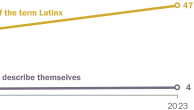Whether a person was born in the United States or abroad is a key demographic characteristic. Foreignborn Latinos more often say they are “some other race” (46 percent) than the native born (40 percent). Cuban-born immigrants are the exception. And, for reasons including intermarriage, whiteness is associated with distance from the immigrant experience (Edmonston et al, 2002). In the 2002 National Survey of Latinos, the U.S.-born children of immigrants more often identified as white than their foreign-born parents, and the share of whiteness was higher still among the grandchildren of immigrants.
Foreign-born Latinos more often say they are “some other race” (46 percent) than the native born (40 percent). Cuban-born immigrants are the exception.
Among the foreign-born, the extent to which white versus SOR identity predominates varies by national origin. For example, at one extreme, 90 percent of naturalized Cubans and 84 percent of non-citizen Cubans identified as white, and at the other extreme only 23 percent of naturalized Dominicans and 21 percent of non-citizen Dominicans identified as white. Yet, with the exception of Central Americans, there is a consistent pattern. A greater share of naturalized immigrants, from 2 to 6 percent more depending on national origin, identify as white when compared to their non-citizen counterparts.





